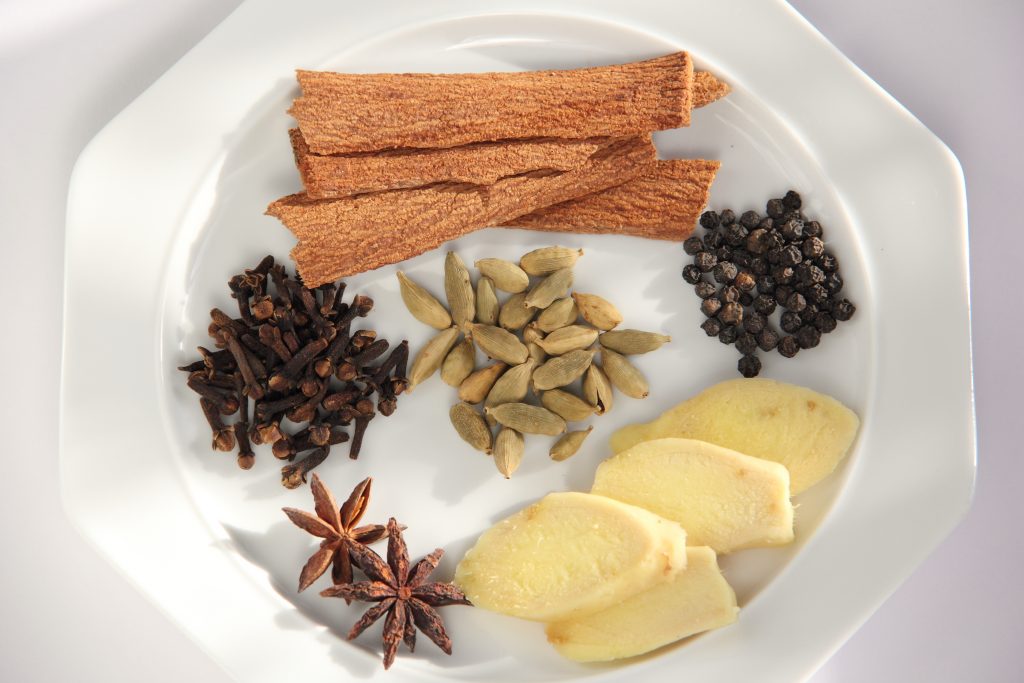Masala chai is black tea made with equal parts water and milk, flavoured with spices and sweetened. ‘Masala’ is a mix of spices and ‘chai’ is the Hindi word for tea. Masala chai is spiced tea.
Masala chai originated in India, and there is no fixed recipe for making this aromatic, black, strong, sweet, milky, spiced tea. Each household has their way of making the tea and use a spice combination that they prefer and one that suits their palette.
Whole spices are generally used when making masala chai but these days you buy pre-made mixes. You can also find masala chai on the menus of many coffee and tea houses.
Personally, I believe that the best way to experience masala chai is to have it made the long way – brewed from scratch with tea leaves along with the whole spices that bloom and flavour the tea. High quality tea bags are not a bad substitute for this particular tea but nothing quite beats making the tea with leaf tea.
There are four (4) components of masala chai – the tea leaves, spices, milk and sweetener.
Tea leaves – you need a strong black tea such as Assam (named after the region where it is produced) or Ceylon black from Sri Lanka, Darjeeling or Nilgiri. It does not have to be any of these teas just as long as it is a strong black tea and a flavour that you enjoy. Wherever possible, use the leaf tea/tealeaves when making masala chai. Average 1 teaspoon of tea leaves per cup of tea.
Spices – there are several spices that make up the list that can be used to make masala chai: green and black cardamom, cinnamon, cloves, star anise, nutmeg, mace, fennel, black peppercorns and fresh root ginger. At no time do you need to use all of the spices, only the ones that when combined with the tea, give you a perfect, spiced cup of tea.
Milk – masala chai is the kind of tea you make when you want to unwind, be quiet and indulge. It is a welcome treat when having fellow tea lovers over for a cuppa and a chat. Quite simply, it is a treat. I say all of this to say that there is no skim, low or non fat milk involved in making masala chai. Whole milk, whether fresh, evaporated, pasteurized or ultra pasteurized is preferred because of the high temperatures at which the tea must be brewed. Using skim, low or non-fat milk will result in the milk curdling at temperatures such as boiling point.
Milk is not added to masala chai after the tea has been brewed and sweetened, rather, it is cooked with the water, tea and spices for a certain amount to time so that the ingredients can truly blend.
Sweetener – sugar is the usual choice but honey can be used as a substitute. Just like the milk, the sweetener is not added after the tea has been brewed. The sugar is added at a certain time to cook with the other ingredients.
It takes time for these 4 components to meld and it should notbe rushed – preparing it or consuming it. It is for this reason that I say, in order to enjoy a proper cup of masala chai, it should be made the long way.

If you are not comfortable making your own masala chai using whole spices and feel intimated about which combination of spices to use, you can try using packaged tea masala until you feel confident enough to make it from scratch.
Here’s the way I make masala chai. Remember that a recipe is only a guide, feel free to use your own combination of spices.
MASALA CHAI
(Makes 4 cups)
2 cups tap water
5–6 tsp. tea leaves/leaf tea
8–10 green cardamom pods, slightly crushed to reveal their seeds
1 large star anise (or 2 small ones)
1 (2 or 3-inch) piece of whole cinnamon
1/2 tsp. whole cloves
1/2 tsp. whole black pepper corns
4–6 slices fresh root ginger (peeled)
Sugar to taste
2 cups whole milk
Add the water and all of the spices to a medium sized pot, cover and place over medium heat. Bring to a boil and let cook for 2 minutes only.
Sweeten with sugar to taste then add the milk. Stir, cover and bring to a boil, when it comes to a boil, reduce the heat to low and let simmer for 8 to 10 minutes.
Strain using a sieve and serve hot.
Cook’s Notes
– As a substitute use your favourite strong black teabag. For the recipe, use 4 to 5 teabags.
– Watch the pot when you add the milk and it comes to a boil because it can froth and run over.
Words & Photos by Cynthia Nelson

